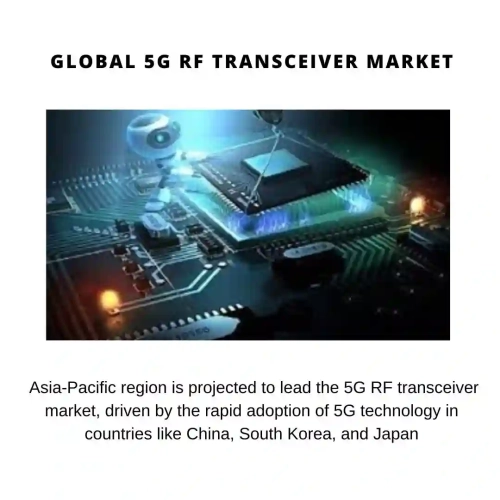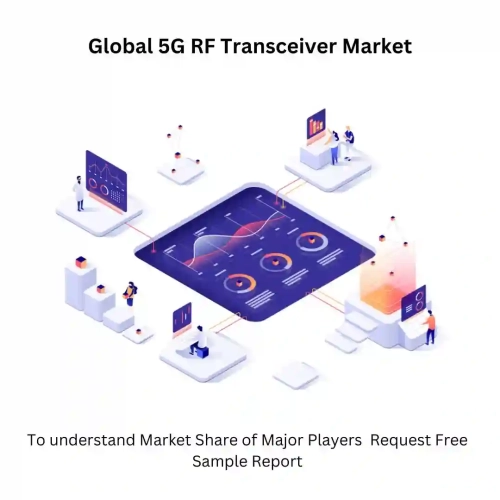
- Get in Touch with Us

Last Updated: Apr 26, 2025 | Study Period: 2024-2030
5G RF transceivers represent a massive leap forward in wireless communication technology. They hold the ability to facilitate high-speed data transfer, low latency, and enhanced network capacity, enabling groundbreaking applications and revolutionizing industries.
The benefits of these transceivers, including improved network efficiency, greater coverage, and energy efficiency, make them a vital component in the realization of a truly interconnected future. As we continue to embrace the power of technology, we are moving toward a world where connectivity knows no bounds.

The 5G RF transceiver plays a vital role in ensuring high-speed data transfer, low latency, and reliable connectivity in 5G networks. With advanced features and capabilities, the 5G RF transceiver facilitates the seamless operation of various 5G applications, including enhanced mobile broadband (eMBB), ultra-reliable low-latency communication (URLLC), and massive machine-type communication (MTC).
Its compact design, low power consumption, and compatibility with legacy protocols make it an essential component for enabling the widespread adoption of 5G technology.
A 5G RF transceiver is the backbone of 5G communication systems. It is responsible for transmitting and receiving radio frequency signals in the 5G frequency bands. The transceiver integrates both the transmitter and receiver functionalities into a single device, enabling efficient communication between the user equipment (UE) and the network.
The emergence of 5G technology in RF transceivers revolves around delivering greater capacity more efficiently. This has all become possible with radio advancements like MIMO, beamforming, and high-density antenna arrays.
These technological advancements empower the wireless revolution by providing a wider frequency range. This expanded frequency spectrum allows engineers to design applications that encompass a broad range of frequencies.
The best example is Analog Devices Inc.'s ADRV9009 RF transceiver, which offers up to 200 MHz of signal bandwidth, twice the previous generation, to support 5G wireless infrastructure equipment. Tunable over 75 MHz to 6 GHz, it supports 2G, 3G, 4G, and 5G wireless networks.
In the revolutionary era of 5G, we have been witnessing the shift from band-specific designs specified for bands to single-chip transceivers.
These innovative single-chip devices are adopting advanced 5G RF architectures to achieve a higher level of integration. Today, these single-chip transceivers combine the various RF building blocks, including the pivotal I/Q modulator, power amplifier (PA), voltage-controlled oscillator (VCO), programmable gain amplifier (PGA), low noise amplifier (LNA), and SPI control interface. This innovative 5G technology presents how these transceivers consolidate the fundamental RF building blocks into one chip.
For example, Texas Instruments' AFE7422, a dual-channel, and AFE7444, a quad-channel RF-sampling transceiver, demonstrate advancements in modern RF transceiver chips. These transceivers support up to 8 antennae and 16 RF bands, eliminating local oscillators, mixers, amplifiers, and filters and optimizing transceiver proximity to the antenna.
The 5G technology integration and compactness of RF transceivers offer cost-effective, space-efficient, and flexible solutions, contributing to the widespread adoption of emerging technologies across various industries and applications, and eliminating the need for external discrete components.
One leading player in compact 5G RF transceivers is Rohde & Schwarz. The companyâs prominent product, the ATS800B, a CATR benchtop antenna test system, is a very compact far-field OTA (over-the-air) test system based on CATR (compact antenna test range) technology. While this specific product is focused on antenna testing, Rohde & Schwarz is renowned for its expertise in RF technology and offers a wide range of compact RF solutions for various applications.

The Global 5G RF transceivers market accounted for $XX Billion in 2023 and is anticipated to reach $XX Billion by 2030, registering a CAGR of XX% from 2024 to 2030.
Arctic Semiconductorâs IceWings: -IceWings is an innovative RF transceiver with four integrated transmitters and receivers. IceWings supports a wide range of standards in signal frequencies below 7.2GHz and enables mmWave applications by intermediate to baseband conversion. IceWings flexibility and integration allow customers to create more reliable platforms, with better yield, lower power consumption, and at a lower cost
China Mobileâs Breaking Wind 8676:- China Mobile recently announced that it had successfully developed China's first reconfigurable 5G radio frequency (RF) transceiver chip "Breaking Wind 8676," effectively enhancing 5G self-reliance. The chip can be widely used in commercial applications such as cloud and home base stations and is responsible for the high-speed conversion of analog and digital signals.
Analog Devices Inc.'s ADRV9009 RF transceiver: - The ADRV9009 is a highly integrated, radio frequency (RF), agile transceiver offering dual transmitters and receivers, integrated synthesizers, and digital signal processing functions. The IC delivers a versatile combination of high performance and low power consumption demanded by 3G, 4G, and 5G macro cell time division duplex (TDD) base station applications.
| Sr. No | Topic |
| 1 | Market Segmentation |
| 2 | Scope of the report |
| 3 | Abbreviations |
| 4 | Research Methodology |
| 5 | Executive Summary |
| 6 | Introduction |
| 7 | Key prediction for the 5G RF transceivers market |
| 8 | Cost breakdown of Product by sub-components and average profit margin |
| 9 | Disruptive Innovation in the Industry |
| 10 | Technology Trends in the Industry |
| 11 | Key drive for 5G RF transceivers market |
| 12 | Manufacturing Footprint for 5G RF transceivers, By Geography |
| 13 | Consumer trends in the industry |
| 14 | Recent Production Milestones |
| 15 | Investment in various industries and impact on5G RF transceivers market |
| 16 | Market Segmentation, Dynamics and Forecast by Geography, 2024-2030 |
| 17 | Market Segmentation, Dynamics and Forecast by Frequency Band, 2024-2030 |
| 18 | Market Segmentation, Dynamics and Forecast by Technology, 2024-2030 |
| 19 | Market Segmentation, Dynamics and Forecast by End-use, 2024-2030 |
| 20 | Product installation rate by OEM, 2023 |
| 21 | Incline/Decline in Average B-2-B selling price in past 5 years |
| 22 | Competition from substitute products |
| 23 | Gross margin and average profitability of suppliers |
| 24 | New product development in past 12 months |
| 25 | M&A in past 12 months |
| 26 | Growth strategy of leading players |
| 27 | Market share of vendors, 2023 |
| 28 | Company Profiles |
| 29 | Unmet needs and opportunity for new suppliers |
| 30 | Conclusion |
| 31 | Appendix |